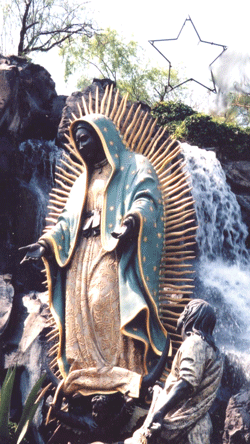Our Lady of Guadalupe—
Dark-skinned Madonna
of the New World
“In her name—
Whose Love is Endless,
Who has never abandoned us.
On the contrary, we have
left Her too long…”
‘La Diosa de las Americas’ by Ana Castillo
Teotihuacan Guadalupe Vision
My first intimate encounter with Our Lady Guadalupe occurred in Mexico in 2003. I had of course, seen numerous shrines in the southwest of the US as well as in every village in Mexico, shrines that are beautiful and well cared for. She is the only vestige of the Black Madonna who made her way into the Americas and perhaps one of the most important female holy presences in the entire region. This is the story of our meeting:
The first rays of Primavera, Spring Equinox sunlight spread over the land to touch the 20,000 pilgrims climbing the Pyramid of the Sun. Plumes of copal incense filled the sky, as Aztec drums beat the ancient rhythms that our bodies could not resist. Feathers of brilliantly colored birds decorated the heads of lead dancers bowing into the circle of those ready to move. Our feet began to pound and rise as we danced to the sun on Teotihuacan’s ancient stone plaza, speaking our prayers to spirit.
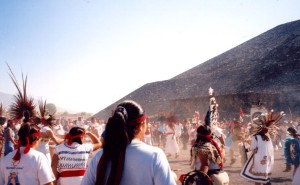
And in stark counterpoint within this sacred ceremonial scene, black military helicopters circled overhead on this first day of the Iraq War, March 21, 2003. Mexico was on high alert with armed militia standing guard at every level of the pyramids of the Sun and Moon.
My friend and I climbed up the steep stone steps of the Pyramid of the Moon to face the rising sun and pray for harmony as our country was invading Iraq. We began to chant and pray to the World Mother, as we knew the bombs were dropping in the mythic land of Eden. My friend and I simultaneously perceived an expansive feminine presence appear above us, floating over the entire earth and spreading flowers and blessings–the more we chanted, the more she multiplied as fractal images of herself spreading more and more beauty and grace.
We continued on our Spring Equinox pilgrimage to visit the shrine of Our Lady of Guadalupe at the Basilica in Mexico City, where we offered red roses and songs. Thousands of families with children gathered at her water shrine where the larger than life sized bronze statues of Aztec warriors humbly bow with offerings to her image at Tepayac, the hill long sacred to the Nahuatl deity Tonantzin.
When we returned a week later and walked into our home, we saw a most extraordinary image of Guadalupe imprinted on our kitchen window. This image stayed clearly visible for at least a month and gave us solace during a very difficult time when so many humans were suffering.

Numinous visitations from a beloved sister-mother
“It’s no coincidence that She’s been appearing more often lately.
In times of crisis, She’s always there.”
Ruben Martinez, author, poet and journalist
Over the last two decades, there has been a dramatic increase in miraculous apparitions of the Virgin of Guadalupe and her Marian sisterhood: She appears on the walls of barrio churches and homes in Los Angeles; she was seen in a perfect likeness in the clouds over Mexico City on her feast day December 12th several years ago; she has appeared in windows of banks and churches and homes throughout North America, with her image often lasting for weeks and becoming a temporary shrine and pilgrimage site.
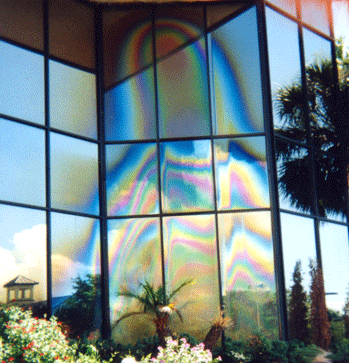
C.G. Jung called the many Marian appearances ‘numinosity’. Mary’s apparitions have been reported in Ireland, Italy, Portugal, Spain, France, Northern Ireland, Switzerland, the Ukraine, Yugoslavia, Korea, Canada, South America, Mexico and the United States. And many news reporters who go to refute the sightings come back with profound religious experiences.
According to author Clarissa Pinkola Estes, Guadalupe appearances and apparitions are: “…visits from a great and beloved sister-mother, who because of long-standing love and familiarity with you, comes through the door without knocking…bringing sweet nourishments to you.”

Our Lady of Guadalupe’s Spanish origins
The name Nuestra Senora Santa Maria de Guadalupe was her Spanish christened name in Extremadura, Spain. The word Guadalupe is a corruption of the Arabic word meaning river of light or river of love. She is among the oldest of Black Virgins as she was given to Spain by Pope Gregory the Great at some date preceding 700 AD. According to Ean Begg in ‘The Cult of The Black Virgin’, when the king of Spain was defeated by the Muslim Saracens in 711 AD, his knights fled with this highly regarded Madonna statue, and buried her in an iron casket near the Guadalupe River in the region of Extremadura.
In 1326 a shepherd discovered the icon following a message and miraculous appearance of Mary and her shrine was erected in Guadalupe, Spain. Interestingly, Begg tells us that Guadalupe was formally crowned as a Black Virgin in 1928 and was associated with the cult of Mary Magdalene. Guadalupe’s name followed her into the Americas when Hernan Cortes, one of her many fervent devotees, arrived from Spain to conquer Tenochtitlan, the center of the powerful Aztec empire, currently the location of Mexico City.
Guadalupe’s Appearance at Tepeyac
“She grows her strongest roses in the soil where they are most needed…
She will appear to you in the midst of upheaval and times when we feel the sky is falling…
She is often most present when there is most need for order, strength, fierceness, hope and vitality.”
Clarissa Pinkola Estes
Ten years after Cortes’ bloody conquest of the mighty Aztec civilization, the cultural fabric of the indigenous people was in fragments and their ceremonial traditions scattered to the four directions. They were a people in crises and in need of spiritual direction. On December 9, 1531 a Nahuatl native named Juan Diego was walking past the sacred hill of Tepeyac, on the northern edge of Tenochtitlan. He heard sweet melodic sounds like the singing of multitudes of heavenly birds. As he looked toward the top of the hill, he saw a shining white cloud with light as bright as many suns and surrounded by a rainbow. As he watched with wonder, a beautiful lady appeared in radiant glowing garments and told him,
“I am the Ever-Virgin Holy Mary, Mother of the God of Great Truth.”
“Her Garments are as the Sun,
gleaming, glittering.
Even the boulder, the crag, on which She takes Her stand
sparkles in Resplendence,
like fine Emerald Jade on a Bangle when it shines,
like the swarming Glow of a Rainbow in the Gloom.
Even the soil, the brambles and prickles
and the rest of the varied weeds that struggle to survive there
are shining like Emerald,
like Divine Turquoise,
to the tip of every leaf;
are glittering like the Golden Scourings of the Gods
up every stalk and twig and thorn.”
Nican Mopohua 16th century Nahuatl document
Guadalupe, affectionately called La Moreneta, then instructed Juan Diego to tell bishop Zumarago in Tenochtitlan that she wanted a church to be built on the sacred hill to serve as a source of loving compassion to all who seek her. Juan Diego followed her request and traveled to give her message to the bishop, who was too busy to listen to the ravings of a humble native man and sent him away. Juan Diego returned to Tepeyac the same day and pleaded with Our Lady to find a more noble messenger, one who might be believed. She instructed him to again return to the bishop and tell him that he was sent by “the Ever-Virgin Mary, the Mother of the God Teotl.” (Teotl is the God of the Nahuatl-Aztecs).
This time, the bishop told Juan Diego to return to him with a sign that would substantiate his claims. Again the Virgin appeared to Juan Diego, and told him to climb the hill and gather the flowers growing there. He found Castilian roses which were miraculously blooming on the hill. This was a variety of Rose only found in Spain, and they could not have bloomed in December at that high elevation. He picked the fragrant roses, which were shining with dew like hundreds of pearls and gathered them into his tilma, or cloak woven of maguey. She instructed him not to open his tilma for anyone until he was in the presence of the bishop.
When Juan Diego returned to the bishop’s office and opened his tilma, the miraclulous roses cascaded onto the floor to reveal an image of Our Lady imprinted on the fabric of his cloak. The bishop and his assistants bowed down and cried for forgiveness to the Blessed Virgin. Later that day, the bishop journeyed to Tepeyac to learn exactly where Our Lady had appeared, and soon the church and hermitage were constructed, which is the current site of the Basilica of Our Lady of Guadalupe.
To the indigenous Nahuatl people of Mexico, Guadalupe was the welcome return of their Mother Goddess after their feminine deities had been driven underground with the male-dominated Aztec culture. Tepeyac had previously been a sacred site for several Nahuatl female deities such as Coatlicue (Serpent Skirt) and Tonantzin (Our Mother). The Nahuatl historical records written in the Nican Mopohua tell us that some of the local natives believed Guadalupe was Tlecuauhtlacupeuh: She Who Comes Flying from the Light Like an Eagle of Fire. Others said she was Tequatlanopeuh: She Whose Origins Were in the Rocky Summit.
“Known as Tonantzin among the Nahuatls, but also as Saint Moon, Queen of Nature,
or Earth Mother in other parts of the Americas, la Guadalupana…
she returns as vessel of the indigenous spirit…
she returns speaking in the inflections of an ancient tongue,
before Christianity, beyond Christianity.
She is among the bearers of the myths, the rites, and the ancient quests.”
Luis Rodriguez, ‘Forgive Me, Mother, for My Crazy Life’
Zumarago, the Spanish Bishop in Mexico during the time of Guadalupe’s visitations at Tepayac, named Guadalupe as the daughter that was to outshine her mother. Certainly this prophetic statement has come true in the Americas.
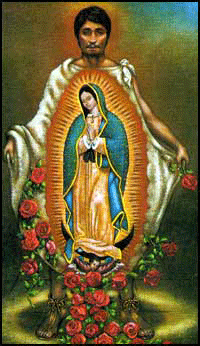
Miraculous Tilma
”Brushes not of this world painted this most sweet icon.”
Pope Pius XII
The image of Guadalupe was imprinted upon a rough natural fiber from the maguey cactus and yet the image is as clear as if it were painted on fine silk. According to research conducted by Kodak of Mexico, the image is smooth and feels like a modern day photograph. The colors have not faded and experts say the loosely woven fabric should have disintegrated after 20-60 years, yet it is still fresh after almost 500 years! Microscopic examination has revealed that there were no brush strokes. Similar to the Shroud of Turin, for all those scientists who have investigated the tilma, it remains a mystery and a miracle.
Much research has also been conducted regarding mysterious images that appear in Guadalupe’s eyes. The images reflected in her two retinas are of the moment when the Virgin left her imprint on Juan Diego’s tilma. According to Peruvian scientist Jose Aste Tonsmann, an expert in digital image processing, the figures in her eyes’ reflection show those historically known to have been present at the unveiling of the tilma in 1531: Namely, Bishop Zumarraga, an interpreter, Juan Diego and several family members.
Guadalupe’s tilma shows the radiant rays of the sun surrounding her as she appeared, wearing a blue-green mantle fit for a queen of royal lineage. Her feet rest upon a crescent moon, just as Isis and those ancient goddesses before her. A four petalled flower rests on her womb, signifying the balance of the four directions and the Nahuatl four sacred movements of the universe (Naui Ollin). She wears a black Aztec maternity belt indicating she is with child. She returns again and again throughout the ages:
“And a great portent appeared in heaven, a woman clothed with the sun, with the moon under her feet, and on her head a crown of twelve stars; she was with child…”
John’s Revelation 11:19a; 12:1-6a
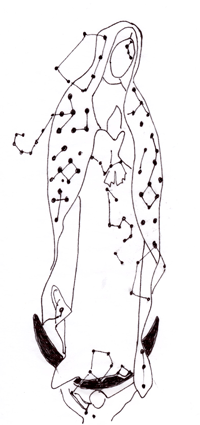 Most fascinating is the pattern of stars strewn across her mantle. The pattern mirrors the exact position of constellations on the day her image appeared on the tilma, December 12, 1531, 10:40 am: The Boreal Crown is located above the Virgin’s head, Virgo is on her chest, in the region of her hands; Leo is on her womb; Gemini the twins are in the region of her knees and Orion is located on the Angel at her feet.
Most fascinating is the pattern of stars strewn across her mantle. The pattern mirrors the exact position of constellations on the day her image appeared on the tilma, December 12, 1531, 10:40 am: The Boreal Crown is located above the Virgin’s head, Virgo is on her chest, in the region of her hands; Leo is on her womb; Gemini the twins are in the region of her knees and Orion is located on the Angel at her feet.
When calculating the astrological chart for Guadalupe’s 1531 appearance, I was struck by the position of Venus at 26 degrees Sagittarius. This degree point is known as our Galactic center and the center of creation for the Mayan and Aztec traditions. (At the time of writing this article in 2006, Pluto was approaching this galactic core degree. For me, this indicates a powerful transformation at our very roots. As it activates Our Lady’s Venus, Pluto signals an unprecedented increase of Venus’ qualities of beauty, love and the sacred feminine rising from the underworld).
Venus and Five Visitations—Five Questions
Venus is the only planet in our solar system which makes a perfect geometric shape in its alignments with the sun. Every eight years the movements of Venus create a perfect five-sided pentagram. Guadalupe’s shrine at Tepeyac has a five-pointed star above Our Lady’s head. In December of 1531, she made a total of five appearances and she asked Juan Diego five questions:
• Am I not here, your Mother?
• Are you not under my shadow and protection?
• Am I not your foundation of life?
• Are you not in the folds of my mantle?
• Is there anything else that you need?
The principle of beauty is inherent within the pentagram–it’s proportions are PHI Golden Mean ratios, reflecting the harmonious ordering of creation. The pentagram has a long association with the inner mysteries of the occult and the goddess. I believe She is calling us to live in harmony, create and honor beauty and practice loving compassion. As Dostoevski once said, “Beauty will save the Earth.”
A Girl Gang Leader in Heaven
“Our Dark Madonna of the Americas is not a docile meek mother.
She is a warrior with her roots growing deep in the Nahuatl Tonantzin
of the sacred hill at Tepayac, and deeper still her roots connect us to Coatlicue,
Serpent Skirt, the darker fierce mother goddess of the Aztecs”.
‘La Diosa de las Americas’ ed. Ana Castillo
Our Lady of the Marian sisterhood gives strength to those who feel disempowered and disenfranchised. Guadalupe has been the standard-bearer for many liberation struggles. She has been the glue that holds together families, communities and countries. Like Joan of Arc, whose banner flew in the French rebellion with the Templar words Jesu—Maria, Maria-Guadalupe’s banner was raised by Poncho Villa and Emiliano Zapata during the Mexican Revolution. Her banner was proudly carried by Cesar Chavez in the California farm workers’ movement and by the Chiapas Zapatista revolutionary movement. She is not a quiet, docile presence, this Madonna, and she is gaining recognition just like her sister Mary Magdalene. Will the voice of the wise feminine be heard and will her presence within us turn the current tide of political and environmental suicide?
Pope Pius XII pronounced Our Lady of Guadalupe to be Empress of the Americas, from Alaska to Tierra del Fuego, South America. The cult of the Black Virgin, who has its roots in Isis, Inanna Ishtar and Mary Magdalene is alive and well in the Americas. She is La Morena, the dark one, rooted in indigenous hearts and elevating all who are missing Mary!
The following poem by Clarrisa P. Estes paints our Guadalupe as the girl we adore:
“Mi Guadalupe is a girl gang leader in heaven.
She is unlike the pale blue serene woman.
She is serene, yes like a great ocean is serene.
She is obedient, yes, like the sunrise
is obedient to the horizon line.
She is sweet, yes,
like a huge forest of sweet maple trees.
She has a great heart, vast holiness
and like any girl gang leader ought,
substantial hips.
Her lap is big enough
to hold every last one.
Her embrace
Can hold us,
All….”
©Ani Williams October 2005
Here is a link to the recording Magdalene’s Gift, which includes the traditional Nahuatl and Spanish song Santa Maria Guadalupe, which is still chanted in her processionals in Mexico: https://aniwilliams.com/product/magdalenes-gift/
